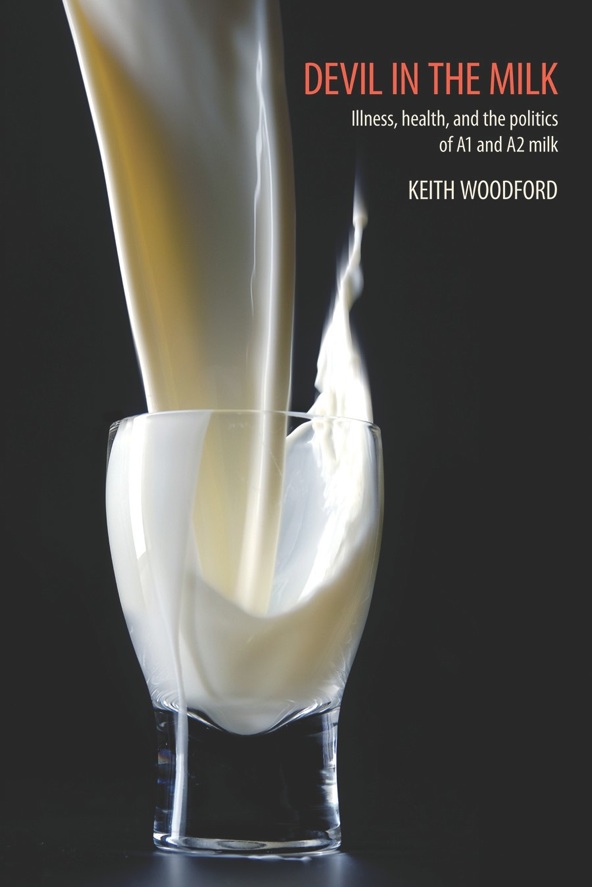




How but in custom and ceremony
Are Innocence and Beauty Born?
—William Butler Yeats
Review of DEVIL IN THE MILK
Monday, October 15, 2012

“If the LORD delight in us, then he will bring us into this land, and give it us; a land which floweth with milk and honey.” Numbers 14:8.
Because the Scriptures repeatedly identify it as a symbol of abundant blessing for God’s people, I cannot believe that animal milk (as some have asserted) is not a suitable food. (God himself drank milk at Abraham’s tent—along with a politically incorrect meal of bread, butter, and red meat. See Genesis 18.) I freely and confidently enjoy drinking tall glasses of delicious, creamy raw milk (served from a jug emblazoned with the ignored dictum “For Pet Consumption Only”).
But milk—particularly cow’s milk—has been increasingly vilified, as connections are made to allergies, heart disease, Type I diabetes, autoimmunity, and even autism. What makes the milk we drink today so damaging to our health? Pasteurization and homogenization have received much attention by the health community, but, according to Keith Woodford, the problem runs as deep as genetics. In his book Devil in the Milk: Illness, Health, and the Politics of A1 and A2, this New Zealand professor of farm management and agribusiness explains that dairy breeding favored cows with a certain genetic mutation.
Milk contains six different proteins, the most prevalent of which is beta-casein—A1 beta-casein or A2 beta-casein. In A1 beta-casein, amino acid position 67 is occupied by histidine. Because histidine is the weak link in the chain, digestion of A1 beta-casein consistently produces a sequence of seven amino acids known as the BCM-7 peptide (beta-casomorphin 7), a highly bioactive opiate. In A2 beta-casein, proline occupies amino acid position 67, and provides such a strong chemical link that it will not break down during digestion to produce BCM-7.
The replacement of proline with histidine in beta-casein is believed to be a genetic mutation that occurred in the Holstein-Friesan breed thousands of years ago. This “black-and-white” breed is overwhelmingly preferred in our country for its unmatched production rate. It is estimated that 80-percent of these cows have the A1 mutation; and since bottled milk is the mixed product of countless cows, virtually all milk in the American market contains A1 beta-casein. So how does A1 beta-casein—specifically the BCM-7 produced during digestion of A1 beta-casein—affect our health?
If the intestinal barrier is compromised, as by ulcers or damaged intestinal villi (the ”leaky gut” syndrome increasingly common due to poor diet), BCM-7 has free entrance into the bloodstream. BCM-7 is a powerful oxidant that promotes heart disease by oxidizing LDL cholesterol and contributing to plaque build-up. BCM-7 promotes diabetes and auto-immune disorders by attaching itself to insulin-producing beta-cells in the pancreas. BCM-7 is a morphin-like opiate that can cross the blood-brain barrier and interfere with brain function, promoting neurological disorders such as schizophrenia and autism.
Those with a healthy, intact gut will absorb minimal BCM-7, but may notice other health effects. BCM-7 inhibits intestinal motility, allowing lactose to ferment in the intestines and thus exacerbating lactose sensitivity and other digestive problems. Most of us have noticed a connection between dairy consumption and increased mucous production that can lead to respiratory infection; for years, scientists were unable to validate this claim, but a recent study demonstrated that BCM-7 selectively binds to the epithelial cells in the mucous membranes and stimulates increased production of thickened mucous.
Woodford’s arguments are based on more than a hundred scientific papers published in international journals, as well as documents from milk-marketing companies. In his heavily footnoted book, Woodford reviews population studies, presents evidence for both sides of the argument, and suggests principles for needed studies. The enthusiasm of Woodford’s years-long research resulted in very personal encounters with scientific betrayal, business battles, and political corruption. The North American edition published by Chelsea Press introduces a health controversy that rocked New Zealand politics several years ago but remains little known in North America.
Although the topic is admittedly beyond the scope of Woodford’s book, he seemed to appreciate too little the health affects of pasteurization. I recommend also reading The Milk Book: The Milk of Human Kindness is Not Pasteurized by William Campbell Douglass, M.D., or watching Mark McAfee’s interview with Sickly Cat Network. ❖
History
October 12, 2010 Originally published as “Devil in the Milk: BCM7 and Your Health” on the blog Cabbages and Kings.
November 1, 2012 Revised and expanded for publication as “Review of DEVIL IN THE MILK” on the blog Linnet on the Leaf.
© Copyright
Samantha Little holds the copyright for the article “Review of DEVIL IN THE MILK” and other content of this site. Readers are welcome to print this page for personal reference only, or to share the URL with others. Please do not reprint or modify this article without written permission from the author. Thank you for your integrity.


